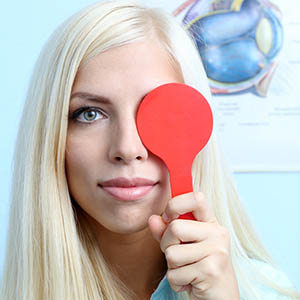Vision therapy can be more effective for adult patients, as they are typically more motivated in therapy.
Once an adult starts to notice the results of vision therapy with their own eyes they realize how beneficial it can be for them, motivating them to improve even further.
What is vision therapy?
Vision therapy is a personalized program of a series of progressive therapeutic eye exercises that help patients improve their visual skills.
The improved visual skills are as a result of enhanced communication between their eyes and the brain. It is an individual and custom-designed treatment program, often used in conjunction with other treatments such as eyeglasses or eye surgery.
Is vision therapy effective for adults?
Many people mistakenly believe that vision therapy is just for children. However, vision therapy is just as effective for adults as it is for children.
Adults can succeed with vision therapy thanks to neuro-plasticity — the brain’s ability to modify, change, and adapt.
Thanks to neuroplasticity, the brain remains dynamic and flexible throughout life. Additionally, adults are usually highly motivated to improve their visual skills, giving them the energy and determination to push through any difficult obstacles and improve their office performance.
Vision therapy can treat a variety of vision conditions:
- Amblyopia (lazy eye)
- Convergence insufficiency (eye teaming)
- Strabismus (eye turn)
Lazy eye and vision therapy
Amblyopia, commonly known as a “lazy eye,” is a neuro-developmental vision condition. Lazy eye develops when one eye is unable to achieve normal visual acuity, causing blurry vision in the affected eye, even with corrective eyewear. The condition also commonly presents with poor depth perception and reading difficulties.
Vision therapy has been shown to considerably improve lazy eye, even in Adults, by re-training the visual system.
Vision therapy for adults can be very effective, but tends to take longer to achieve optimum results. Ultimately, adults can often train their eyes to work together to achieve clear and comfortable binocular vision.
Vision therapy programs may include treatment for:
- Accommodation (focusing)
- Pursuits (eye tracking)
- Fixation (visual gaze)
- Saccades (switching eye focus, “eye jumps”)
- Stereopsis (3-D vision)
- Spatial skills (eye-hand coordination)
Schedule an appointment with a vision therapy eye doctor to help improve your visual skills.
SEE RELATED: New Research for Adults with Lazy Eye
Convergence insufficiency and vision therapy
Convergence insufficiency (CI) is a binocular vision condition that can affect adults.
Convergence insufficiency affects eye muscle and near vision coordination. Convergence of the eyes occurs when the two eyes need to focus on a close object, such as a book or computer. Convergence insufficiency means the eyes struggle to focus for near tasks like reading and writing, affecting attention to tasks and work performance`.
Vision therapy is the most effective treatment for CI, as standard eyeglasses, contact lenses, medications, and surgery cannot treat the condition.
In many cases, your eye doctor will prescribe prismatic (prism) glasses in combination with vision therapy, as they decrease some CI symptoms. Although prism eyeglasses can relieve symptoms, they are not a “cure” and the patient typically remains dependent on the prism lenses.
Vision therapy focuses on training the eyes to work together to improve depth perception, clear binocular vision and 3-D vision. The goal of vision therapy is to stimulate the communication between the eyes and brain, to enable clear and comfortable vision at all times.
Treatment exercises for CI may include:
- Depth perception practice
- Focusing for near and distance
- Eye tracking with pursuits and saccades
- Training with computerized technology
- Specialized equipment and tools such as prisms and lenses
Eye turns (strabismus) and vision therapy
Strabismus occurs when the two eyes are unable to focus together on one object and maintain proper alignment — one eye looks directly at the object, while the other eye points in a different direction. Strabismus does not go away on its own.
Vision therapy can a highly effective treatment for adults with eye turns and strabismus.
A vision therapy program for strabismus can help improve:
- Binocular vision
- Eye alignment
- Eye focusing
- Eye teaming
- Eye movements
- Visual processing
A vision therapy program for strabismus may include therapeutic lenses, prisms and filters. Vision therapy involves ocular muscle training as well as training and development of the eye-brain connections required for clear and comfortable vision — resulting in a lasting cure.
A vision therapy program is sometimes recommended by your eye doctor after strabismus surgery in order to re-train the visual system. It is important to treat strabismus as early as possible, as the eye turn may be a result of a serious health issue.
LEARN MORE: Vision Therapy for Lazy Eye
Schedule a vision therapy evaluation to discuss whether a vision therapy program is the appropriate treatment for you.
Vision therapy might just be the solution you have been looking for.










